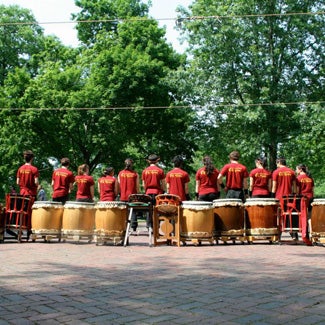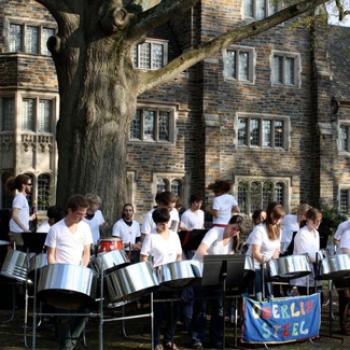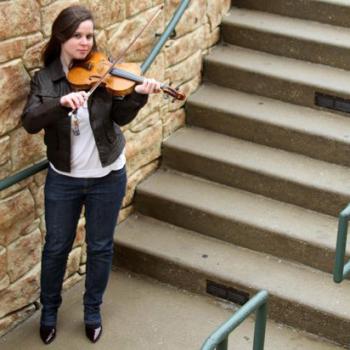On being a part of OCTaiko
Yue Qiu ’14
“...being a good taiko drummer is not so much having the perfect techniques; it is more a commitment to being part of a group that shares the same energy and tries to figure out the key to ki together.”

Coming from a traditional Chinese educational background, where I was constantly told that the ultimate goal for students of my age is to study hard and study harder, I was utterly surprised and intimidated by all the different ExCo classes one could take for credit here at Oberlin. I remember walking into the Root Room in the Carnegie Building for the ExCo Fair. It was packed with a few dozen demonstration stations and hundreds of other students shopping for ExCo classes. Some were signing up for three classes right away. Others were just as overwhelmed as I was. There were classes like fencing, jewelry making, tai chi, Harry Potter, and tap dancing. It seemed like the only subjects missing from the list were “too fun,” “not serious,” and “not academic.”
I applied to a few ExCos, a process during which I had to answer questions like “Why this ExCo?” and even “If you were a piece of furniture, what would you be? Draw a picture.” Three days after the fair, I got an e-mail from Amelea Kim starting with “Congratulations,” and I was officially part of the Taiko ExCo class with 20-some other people.
The first class was different from what I had expected. Instead of putting us to the drums, the instructors (members of collegiate taiko ensemble OC Taiko) asked us to stand in a circle and start clapping, making back beats. This is called a kiai circle, where each person in the circle makes a eight-beat long call or shout or whatever loud sound they could make to vocalize their ki and give energy to the group. Someone started the circle by shouting “ah------” and other kiai, knees bent and mouth wide open. I had prepared myself for some serious down-to-business banging on the drums for the first practice, so I wasn’t quite sure if I could do the same. I remember my first kiai being maybe half as long and half as loud, and absolutely no wide-opened mouth or other body motions.
I spent almost the entire fall semester learning how to be a “good” drummer. I thought all I had to do was just to play the hits exactly on beat, and pose my arms and my body precisely in the right place. When other people made kiai when they were playing a piece, I hid behind their voices and thought it’d be fine to just hit the right place at a right time.
Now two semesters after that first ExCo fair, I have applied to and become a part of an incredible group of people: Oberlin College Taiko. And I now have much better kiai. I have learned to focus less on the mechanisms and the repertoire. Instead, I focus on the energy ki of being in an ensemble and playing with other people.
In one of my favorite pieces called “hiryu sandan gaeshi,” extensive kiai is incorporated into the repertoire. I still remember the first time performing it; I shouted out the loudest kiai ever and looked into the eyes of other members whenever I turned around. It was more clear than ever to me that being a good taiko drummer is not so much having the perfect techniques; it is more a commitment to being part of a group that shares the same energy and tries to figure out the key to ki together.
Now I no longer have problem doing kiai circle, although maybe still no bent knees or wide-opened mouth. My experience with the Taiko ExCo and OC Taiko has definitely challenged and widened my definition of both learning and performing.
Tags:
You may also like

On joining OSteel
“I loved that I began to feel like a good musician even though my musical experience had been limited since age 10, when I quit piano.”
Alicia Dudziak ’13

On living the double-degree life
“There was no holding me back, and I plunged into both areas of study. My weekday schedule was intense ... the discipline to practice and study, the drive to learn came from inside.”
Nancy Chapple ’83

On founding Violin for Vasculitis
“I am more often labeled an “activist” than a “touring violin virtuoso,” [but] that doesn’t alter my goal. I am musically fulfilled through this project more than I ever could be as a healthy...
Allison Lint ’09